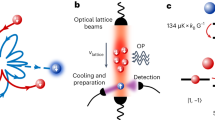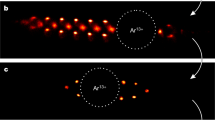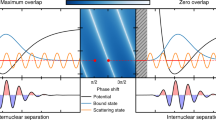Abstract
The control of physical systems and their dynamics on the level of individual quanta underpins both fundamental science and quantum technologies. Trapped atomic and molecular systems, neutral1 and charged2, are at the forefront of quantum science. Their extraordinary level of control is evidenced by numerous applications in quantum information processing3,4 and quantum metrology5,6. Studies of the long-range interactions between these systems when combined in a hybrid atom–ion trap7,8 have led to landmark results9,10,11,12,13,14,15,16,17,18,19. However, reaching the ultracold regime—where quantum mechanics dominates the interaction, for example, giving access to controllable scattering resonances20,21—has so far been elusive. Here we demonstrate Feshbach resonances between ions and atoms, using magnetically tunable interactions between 138Ba+ ions and 6Li atoms. We tune the experimental parameters to probe different interaction processes—first, enhancing three-body reactions22,23 and the related losses to identify the resonances and then making two-body interactions dominant to investigate the ion’s sympathetic cooling19 in the ultracold atomic bath. Our results provide deeper insights into atom–ion interactions, giving access to complex many-body systems24,25,26,27 and applications in experimental quantum simulation28,29,30.
This is a preview of subscription content, access via your institution
Access options
Access Nature and 54 other Nature Portfolio journals
Get Nature+, our best-value online-access subscription
$29.99 / 30 days
cancel any time
Subscribe to this journal
Receive 51 print issues and online access
$199.00 per year
only $3.90 per issue
Buy this article
- Purchase on Springer Link
- Instant access to full article PDF
Prices may be subject to local taxes which are calculated during checkout




Similar content being viewed by others
Data availability
The experimental and theoretical data that support the findings of this study are available from the corresponding author upon request. Source data are provided with this paper.
Code availability
The experimental data were analysed using JupyterLab and a self-written analysis script. Electronic structure calculations were performed with the MOLPRO package of ab initio programs67 and multichannel quantum scattering calculations were realized with the extended version of QDYN program68. AMB model results were obtained and analysed with a self-written program and scripts in Mathematica and Python. The simulation results can be generated using the numerical methods described within Methods and the computer code developed, which are available upon request.
References
Bloch, I., Dalibard, J. & Zwerger, W. Many-body physics with ultracold gases. Rev. Mod. Phys. 80, 885–964 (2008).
Leibfried, D., Blatt, R., Monroe, C. & Wineland, D. Quantum dynamics of single trapped ions. Rev. Mod. Phys. 75, 281–324 (2003).
Wineland, D. Nobel lecture: Superposition, entanglement, and raising Schrödinger’s cat. Rev. Mod. Phys. 85, 1103–1114 (2013).
Saffman, M., Walker, T. & Mølmer, K. Quantum information with Rydberg atoms. Rev. Mod. Phys. 82, 2313–2363 (2010).
Katori, H. Optical lattice clocks and quantum metrology. Nat. Photon. 5, 203–210 (2011).
Micke, P. et al. Coherent laser spectroscopy of highly charged ions using quantum logic. Nature 578, 60–65 (2020).
Härter, A. & Hecker Denschlag, J. Cold atom–ion experiments in hybrid traps. Contemp. Phys. 55, 33–45 (2014).
Tomza, M. et al. Cold hybrid ion–atom systems. Rev. Mod. Phys. 91, 035001 (2019).
Grier, A., Cetina, M., Oručević, F. & Vuletić, V. Observation of cold collisions between trapped ions and trapped atoms. Phys. Rev. Lett. 102, 223201 (2009).
Rellergert, W. G. et al. Measurement of a large chemical reaction rate between ultracold closed-shell 40Ca atoms and open-shell 174Yb+ ions held in a hybrid atom–ion trap. Phys. Rev. Lett. 107, 243201 (2011).
Ratschbacher, L., Zipkes, C., Sias, C. & Köhl, M. Controlling chemical reactions of a single particle. Nat. Phys. 8, 649–652 (2012).
Hall, F., Aymar, M., Raoult, M., Dulieu, O. & Willitsch, S. Light-assisted cold chemical reactions of barium ions with rubidium atoms. Mol. Phys. 111, 1683–1690 (2013).
Ratschbacher, L. et al. Decoherence of a single-ion qubit immersed in a spin-polarized atomic bath. Phys. Rev. Lett. 110, 160402 (2013).
Meir, Z. et al. Dynamics of a ground-state cooled ion colliding with ultracold atoms. Phys. Rev. Lett. 117, 243401 (2016).
Saito, R. et al. Characterization of charge-exchange collisions between ultracold 6Li atoms and 40Ca+ ions. Phys. Rev. A 95, 032709 (2017).
Joger, J. et al. Observation of collisions between cold Li atoms and Yb+ ions. Phys. Rev. A 96, 030703 (2017).
Fürst, H. et al. Dynamics of a single ion-spin impurity in a spin-polarized atomic bath. Phys. Rev. A 98, 012713 (2018).
Sikorsky, T., Meir, Z., Ben-Shlomi, R., Akerman, N. & Ozeri, R. Spin-controlled atom–ion chemistry. Nat. Commun. 9, 920 (2018).
Feldker, T. et al. Buffer gas cooling of a trapped ion to the quantum regime. Nat. Phys. 16, 413–416 (2020).
Idziaszek, Z., Simoni, A., Calarco, T. & Julienne, P. Multichannel quantum-defect theory for ultracold atom–ion collisions. New J. Phys. 13, 083005 (2011).
Tomza, M., Koch, C. & Moszynski, R. Cold interactions between an Yb+ ion and a Li atom: prospects for sympathetic cooling, radiative association, and Feshbach resonances. Phys. Rev. A 91, 042706 (2015).
Härter, A. et al. Single ion as a three-body reaction center in an ultracold atomic gas. Phys. Rev. Lett. 109, 123201 (2012).
Krükow, A., Mohammadi, A., Härter, A. & Denschlag, J. H. Reactive two-body and three-body collisions of Ba+ in an ultracold Rb gas. Phys. Rev. A 94, 030701 (2016).
Cote, R., Kharchenko, V. & Lukin, M. Mesoscopic molecular ions in Bose–Einstein condensates. Phys. Rev. Lett. 89, 093001 (2002).
Casteels, W., Tempere, J. & Devreese, J. Polaronic properties of an ion in a Bose–Einstein condensate in the strong-coupling limit. J. Low Temp. Phys. 162, 266–273 (2011).
Jachymski, K. & Negretti, A. Quantum simulation of extended polaron models using compound atom–ion systems. Phys. Rev. Res. 2, 033326 (2020).
Hirzler, H. et al. Controlling the nature of a charged impurity in a bath of Feshbach dimers. Phys. Rev. Res. 2, 033232 (2020).
Doerk, H., Idziaszek, Z. & Calarco, T. Atom–ion quantum gate. Phys. Rev. A 81, 012708 (2010).
Gerritsma, R. et al. Bosonic Josephson junction controlled by a single trapped ion. Phys. Rev. Lett. 109, 080402 (2012).
Bissbort, U. et al. Emulating solid-state physics with a hybrid system of ultracold ions and atoms. Phys. Rev. Lett. 111, 080501 (2013).
Inouye, S. et al. Observation of Feshbach resonances in a Bose–Einstein condensate. Nature 392, 151–154 (1998).
Inouye, S. et al. Observation of heteronuclear Feshbach resonances in a mixture of bosons and fermions. Phys. Rev. Lett. 93, 183201 (2004).
Barbé, V. et al. Observation of Feshbach resonances between alkali and closed-shell atoms. Nat. Phys. 14, 881–884 (2018).
Yang, H. et al. Observation of magnetically tunable Feshbach resonances in ultracold 23Na40K + 40K collisions. Science 363, 261–264 (2019).
Aikawa, K. et al. Bose–Einstein condensation of erbium. Phys. Rev. Lett. 108, 210401 (2012).
Durastante, G. et al. Feshbach resonances in an erbium–dysprosium dipolar mixture. Phys. Rev. A 102, 033330 (2020).
Cetina, M., Grier, A. & Vuletić, V. Micromotion-induced limit to atom–ion sympathetic cooling in Paul traps. Phys. Rev. Lett. 109, 253201 (2012).
Chen, K., Sullivan, S. T. & Hudson, E. R. Neutral gas sympathetic cooling of an ion in a Paul trap. Phys. Rev. Lett. 112, 143009 (2014).
Höltkemeier, B., Weckesser, P., López-Carrera, H. & Weidemüller, M. Buffer-gas cooling of a single ion in a multipole radio frequency trap beyond the critical mass ratio. Phys. Rev. Lett. 116, 233003 (2016).
Rouse, I. & Willitsch, S. Superstatistical energy distributions of an ion in an ultracold buffer gas. Phys. Rev. Lett. 118, 143401 (2017).
Lambrecht, A. et al. Long lifetimes and effective isolation of ions in optical and electrostatic traps. Nat. Photon. 11, 704–707 (2017).
Schmidt, J. et al. Optical trapping of ion Coulomb crystals. Phys. Rev. X 8, 021028 (2018).
Weckesser, P. et al. Trapping, shaping, and isolating of an ion Coulomb crystal via state-selective optical potentials. Phys. Rev. A 103, 013112 (2021).
Schmidt, J., Weckesser, P., Thielemann, F., Schaetz, T. & Karpa, L. Optical traps for sympathetic cooling of ions with ultracold neutral atoms. Phys. Rev. Lett. 124, 053402 (2020).
Schneider, C., Enderlein, M., Huber, T., Dürr, S. & Schaetz, T. Influence of static electric fields on an optical ion trap. Phys. Rev. A 85, 013422 (2012).
Ticknor, C., Regal, C., Jin, D. & Bohn, J. Multiplet structure of Feshbach resonances in nonzero partial waves. Phys. Rev. A 69, 042712 (2004).
Cui, Y. et al. Observation of broad d-wave Feshbach resonances with a triplet structure. Phys. Rev. Lett. 119, 203402 (2017).
Maier, T. et al. Emergence of chaotic scattering in ultracold Er and Dy. Phys. Rev. X 5, 041029 (2015).
Köhler, T., Góral, K. & Julienne, P. Production of cold molecules via magnetically tunable Feshbach resonances. Rev. Mod. Phys. 78, 1311 (2006).
Wester, R. Radiofrequency multipole traps: tools for spectroscopy and dynamics of cold molecular ions. J. Phys. B 42, 154001 (2009).
Jochim, S. et al. Magnetic field control of elastic scattering in a cold gas of fermionic lithium atoms. Phys. Rev. Lett. 89, 273202 (2002).
Luo, L. et al. Evaporative cooling of unitary Fermi gas mixtures in optical traps. New J. Phys. 8, 213 (2006).
Ketterle, W. & Martin W. Z. Making, probing and understanding ultracold Fermi gases. La Rivista del Nuovo Cimento 31, 247–422 (2008).
Grimm, R., Weidemüller, M. & Ovchinnikov, Y. in Advances in Atomic, Molecular, and Optical Physics (eds Bederson, B. & Walther, H.) Vol. 42, 95–170 (Elsevier, 2000).
Karpa, L. Trapping Single Ions and Coulomb Crystals with Light Fields (Springer, 2019).
Maxwell, J. A Treatise on Electricity and Magnetism Vol. 1 (Clarendon, 1873).
Krükow, A. et al. Energy scaling of cold atom–atom–ion three-body recombination. Phys. Rev. Lett. 116, 193201 (2016).
Pérez-Ros, J. & Greene, C. H. Universal temperature dependence of the ion–neutral–neutral three-body recombination rate. Phys. Rev. A 98, 062707 (2018).
Pérez-Ros, J. & Greene, C. Communication: Classical threshold law for ion–neutral–neutral three-body recombination. J. Chem. Phys. 143, 041105 (2015).
Mohammadi, A. et al. Life and death of a cold BaRb+ molecule inside an ultracold cloud of Rb atoms. Phys. Rev. Res. 3, 013196 (2021).
Breit, G. & Rabi, I. Measurement of nuclear spin. Phys. Rev. 38, 2082–2083 (1931).
Zhang, J. et al. P-wave Feshbach resonances of ultracold 6Li. Phys. Rev. A 70, 030702 (2004).
Mies, F., Williams, C., Julienne, P. & Krauss, M. Estimating bounds on collisional relaxation rates of spin-polarized 87Rb atoms at ultracold temperatures. J. Res. Natl Inst. Stand. Technol. 101, 521–535 (1996).
Tscherbul, T., Brumer, P. & Buchachenko, A. Spin–orbit interactions and quantum spin dynamics in cold ion–atom collisions. Phys. Rev. Lett. 117, 143201 (2016).
Wille, E. et al. Exploring an ultracold Fermi–Fermi mixture: interspecies Feshbach resonances and scattering properties of 6Li and 40K. Phys. Rev. Lett. 100, 053201 (2008).
Tiecke, T., Goosen, M., Walraven, J. & Kokkelmans, S. Asymptotic-bound-state model for Feshbach resonances. Phys. Rev. A 82, 042712 (2010).
Werner, H.-J., Knowles, P. J., Knizia, G., Manby, F. R. & Schütz, M. Molpro: a general-purpose quantum chemistry program package. WIRES Comput. Mol. Sci. 2, 242–253 (2012).
Goerz, M. H., Reich, D. M., Tomza, M. & Koch, C. QDYN, version 1.0, a program package for quantum dynamics and control (2015); https://qdyn-library.net
Acknowledgements
This project has received funding from the European Research Council (ERC) under the European Union’s Horizon 2020 research and innovation programme (grant number 648330) and was supported by the Georg H. Endress foundation. P.W., F.T. and T.S. acknowledge support from the DFG within the GRK 2079/1 programme. P.W. gratefully acknowledges financial support from the Studienstiftung des deutschen Volkes. L.K. is grateful for financial support from Marie Curie Actions. D.W., A.W. and M.T. acknowledge the financial support from the National Science Centre Poland (grant numbers 2016/23/B/ST4/03231 and 2020/36/T/ST2/00591) and Foundation for Polish Science within the First Team programme co-financed by the European Union under the European Regional Development Fund. K.J. acknowledges support from the Polish National Agency for Academic Exchange (NAWA) via the Polish Returns 2019 programme. The computational part was partially supported by the PL-Grid Infrastructure. We thank O. Dulieu for discussions. We thank M. Debatin for building the experimental apparatus.
Author information
Authors and Affiliations
Contributions
T.S. conceived the experiments. P.W. and F.T. contributed equally to the construction of the setup, carrying out of the experiments, discussion of the results and analysis of the data and were supported by L.K. and T.W. D.W., A.W., K.J. and M.T. performed theoretical calculations and analysis supervised by M.T. T.S. supervised the work. P.W. and T.S. wrote the manuscript with contributions from T.W., K.J. and M.T. All authors worked on the interpretation of the data and contributed to the final manuscript.
Corresponding author
Ethics declarations
Competing interests
The authors declare no competing interests.
Additional information
Peer review information Nature thanks Takashi Mukaiyama and the other, anonymous, reviewer(s) for their contribution to the peer review of this work.
Publisher’s note Springer Nature remains neutral with regard to jurisdictional claims in published maps and institutional affiliations.
Extended data figures and tables
Extended Data Fig. 1 Electronic level scheme of 138Ba+ (I = 0).
We label the relevant electronic dipole transitions with their respective wavelength \(\lambda \) and natural linewidth Γ. We Doppler cool the ion driving the \(6{{\rm{S}}}_{1/2}\leftrightarrow 6{{\rm{P}}}_{1/2}\) and \(5{{\rm{D}}}_{3/2}\leftrightarrow 6{{\rm{P}}}_{1/2}\) transition. Inelastic losses, such as TBR followed by light-assisted dissociation, can partially result in the ion’s population of the 5D5/2 manifold60. We detect these events through optical pumping with 614 nm laser light, followed by fluorescence detection while Doppler cooling.
Extended Data Fig. 2 Time-dependent Ba+ and Li loss for variable atomic density n around 296.31G.
(upper) Ion survival probability while interacting with the 6Li cloud for various atomic densities n. Data points are an average of at least 20 independent experimental realizations. Error bars denote the upper bound of the 1σ-confidence interval of the underlying binomial distribution. The solid lines are exponential fits \(({e}^{-{t}_{{\rm{int}}}{\varGamma }_{{\rm{Loss}}}})\) to the respective data. The fit results and the respective error bars are illustrated as density-dependent loss rate \({\varGamma }_{{\rm{Loss}}}(n)\) in Fig. 3. (lower) Normalized number of remaining 6Li atoms interacting with a single 138Ba+ ion in dependence on \({t}_{{\rm{int}}}\). The markers and the respective colors indicate the association to the data in the upper graph. Li atoms are removed from the xODT by either spin-changing collisions or elastic atom-ion interactions. For the presented analysis, we exclude experiments resulting in ion loss, to avoid systematic errors by inelastic collisions. To mitigate the density uncertainty due to the decay of the atom number, we choose interaction durations resulting in maximal atom loss of \(\lesssim 10 \% \). We further indicate the atom number evolution in absence of interaction (black circles and solid line).
Extended Data Fig. 3 Potential energy curves for a Ba+ ion interacting with a Li atom.
The interaction between ground-state Ba+ ion and Li atom results in two molecular electronic states of the singlet \({X}^{1}{\Sigma }^{+}\) (solid black line) and triplet \({a}^{3}{\Sigma }^{+}\) (solid red line) symmetries. The excited molecular electronic state of the triplet \({b}^{3}\Pi \) symmetry (dashed red line) originates from the interaction of Ba+ ion in the lowest excited \({}^{2}D\) state and ground-state Li atom and crosses the \({a}^{3}{\Sigma }^{+}\) state at a small interatomic distance. This crossing combined with SOC between \({a}^{3}{\Sigma }^{+}\) and \({b}^{3}\Pi \) states results in large second-order SOC in the collision channels responsible for the observed Feshbach resonances. Further illustrated is a possible photodissociation transition induced by our xODT laser operated at 1064 nm. The observed TBR might result in the formation of weakly-bound molecular ions. These can couple by laser light to higher energetic asymptotes, resulting in the population of excited states, including Ba \({}^{+}(5{{\rm{D}}}_{5/2})\).
Rights and permissions
About this article
Cite this article
Weckesser, P., Thielemann, F., Wiater, D. et al. Observation of Feshbach resonances between a single ion and ultracold atoms. Nature 600, 429–433 (2021). https://doi.org/10.1038/s41586-021-04112-y
Received:
Accepted:
Published:
Issue Date:
DOI: https://doi.org/10.1038/s41586-021-04112-y
This article is cited by
-
Field-linked resonances of polar molecules
Nature (2023)
-
Many-body bound states and induced interactions of charged impurities in a bosonic bath
Nature Communications (2023)
-
Trap-assisted formation of atom–ion bound states
Nature Physics (2023)
-
Translational symmetry breaking binds atoms and ions
Nature Physics (2023)
-
Laser-induced forced evaporative cooling of molecular anions below 4 K
Nature Physics (2023)
Comments
By submitting a comment you agree to abide by our Terms and Community Guidelines. If you find something abusive or that does not comply with our terms or guidelines please flag it as inappropriate.



